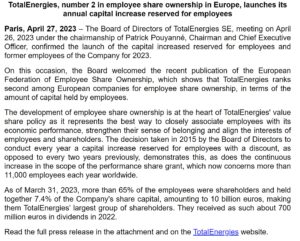The end of the neo-liberal global order will entail changes in the current alignment of Capital and Labor. I use those terms in capitalized form to evoke an earlier time and place where political economy was all about the relationship between the two. That is no longer even remotely the case. Three full decades of globalization and deregulation have meant that any presumed approximate balance between the two in the US has been long discarded in favor of a largely unfettered Wall Street. The upcoming refresh between businesses and their workforces will be the topic of many other books, but there is one area where capital markets practice might be part of the new paradigm.
That practice is stock-based compensation (SBC). In its current variant, SBC is a largely cashless exercise. Among start up and pre-revenue and pre-profit companies, it is used to hire and retain employees. They pay in shares because they have no cash to do so. With the prospect of a cashout down the road via an IPO or an acquisition, SBC is that pot of gold at the end of the stock market rainbow. For larger, more successful companies, especially those in the new economy, SBC is a form of enhanced compensation for executives. Large grants of options or restricted stock are supposed to align the interests of executives and shareholders. Because these companies often have no or de minimis dividends—think the FAANGS et al—the focus is necessarily on the share price. As a result, this compensation tool shares the same flaw of harvesting capital gains versus getting a dividend: The only way to realize any value at all is by selling the shares in the casino. Share ownership is not encouraged; share selling is.
More relevant here is that the current form of SBC offers a visible manifestation of the state of relations between management and employees. In Silicon Valley, nobody may see the problem. It has been a path to riches for those in the tech economy. In the broader economy, however, SBC of dividend free and dividend light stocks is a pitch-perfect example of the “financialization” of the capital markets. In this context, rank & file employees of mature companies, if they get shares at all as part of their compensation, have little incentive to keep them. They have plenty of reason to be suspicious. Older employees might recall Enron, where a retirement plan loaded with company shares—around 60% of total plan assets—devastated the retirement plans of employees when the Enron shares collapsed in just a few weeks 2007.
Company shares are still eligible to be included in company sponsored 401(k) programs, but are viewed with a well warranted degree of suspicion. Employees with the option of owning company shares are warned about the risk of “doubling down” on company risk—their dayjobs and their retirement accounts. The fiduciary responsibility of program administrators contributes to the caution about too heavy a concentration in company shares.
With that history and those restrictions in place, suggesting that employees of publicly traded companies should once again have access to company shares needs a strong justification. That justification is the return of the cash nexus. Here it might be helpful to look to past practice. The creator of the initial Employee Stock Ownership Plan (ESOP) in 1956, the attorney and political economist Louis Kelso, saw employee ownership of companies as a boon for many reasons. The challenge was in financing the purchase of the shares since few employees could afford them outright or borrow money to do so. (These shares were not being granted by the company; they were being purchased from the original owners.) His innovation was in having the company’s retirement plan, as a separate legal entity, borrow the money to purchase company shares and use the dividends—yes the dividends—to help pay back the loan. The idea only made sense because successful companies paid dividends at the time. As the Louis Kelso Foundation website states, he created “the prototype of the leveraged buy-out … to enable working people without savings to buy stock in their employer company and pay for it out of its future dividend yield.”[1] Kelso’s original version of the ESOP was unwieldly, narrow, and designed mostly as a succession tool. It became less unwieldy as a result of the 1974 Employee Retirement Security Retirement Act (ERISA). Employee ownership of shares became easier with the introduction of the 401(k) program in 1978.
With the current change in the political economy paradigm, it is time to revisit employee ownership. I tried to do so a decade ago in The Dividend Imperative (2013). At the time, the idea got no traction. Rates were still going down and non-dividend paying stocks were still going up. But fast-forward a decade and yield matters again. In that context, employee ownership of shares in large successful, cash generative companies with material dividends now makes sense. The format—ESOP, 401(k), taxable accounts—matters less than the incentive. Employees getting a material and rising dividend have a reason to hold the shares, watch the checks come in, and be aligned with other shareholders. The French energy company, Total, is already there. This press release from early 2023 authorizing additional shares for employees is a great description of the idea, with the company noting the 700 million Euros in dividends received by employees during the prior year.

With a yield of around 5% per year in cash dividends, the Total shares are desirable to hold, not sell, upon vesting or grant. As dividend yields rise for the US market, I expect many large cashflow generative companies will move in this direction over the next decade.
[1] https://kelsoinstitute.org/louiskelso/kelso-paradigm/who-what-and-why/